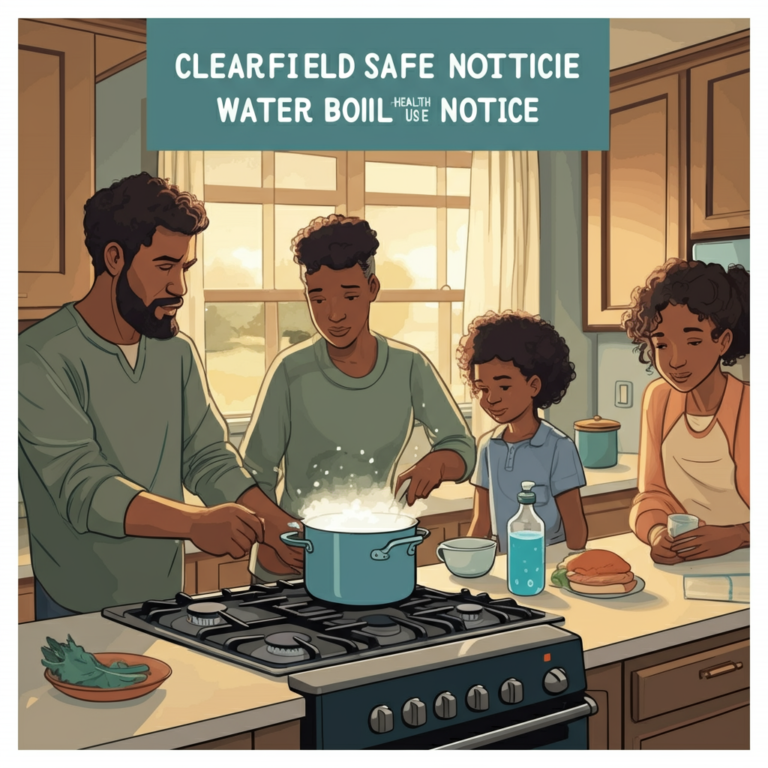When a Clearfield water boil notice is issued, it’s essential to take swift action to ensure your safety, your family’s, and your community’s safety. These advisories occur when the safety of the local water supply is compromised, potentially exposing residents to harmful contaminants. Following the recommended safety measures can protect your health and prevent illness.
This comprehensive guide will explain what a water boil notice means, how to stay safe, and what steps to take once the advisory is lifted.
Table of Contents
What Does a “Boil Water Notice” Mean?
Health or water authorities issue a boil water notice when the public water supply may be contaminated with harmful bacteria, viruses, or other pathogens that could cause illness. Common reasons for these advisories include:
- Broken water lines.
- Power outages affecting water treatment.
- Flooding or other natural disasters.
- Routine maintenance of water supply systems.
Boiling water kills these microorganisms, making the water safe until the issue is resolved. Ignoring these warnings can expose individuals to health risks like diarrhoea, nausea, stomach cramps, and other waterborne illnesses.
Where to Find Official Updates
To stay informed, rely on trusted sources like:
- Your local health department’s website or social media channels.
- Clearfield’s municipal water authority.
- Emergency notifications via TV, radio, or mobile alerts.
Always verify information through official channels to avoid misinformation.
Step-by-Step Guide to Safe Water Use
Following these steps during a water boil notice will ensure your household remains safe.
1. How to Boil Water Correctly
- Fill a clean pot with tap water.
- Heat the water until it reaches a rolling boil.
- Continue boiling for at least one minute to kill harmful bacteria or viruses.
- Allow the water to cool before storing it in a clean, covered container.
2. Safe Practices for Drinking and Cooking
- Use boiled water for drinking, cooking, and preparing beverages like coffee or tea.
- Wash fruits and vegetables, and cook utensils with boiled water for food preparation.
- If boiling water isn’t possible, use bottled water as an alternative.
3. Personal Hygiene
- Brush your teeth with boiled water. Even a tiny amount of unboiled water can introduce harmful pathogens into your system.
- For bathing or showering: Adults and older children can safely bathe but should avoid ingesting water.
- Sponge baths with boiled and cooled water are recommended for infants and young children to prevent accidental ingestion.
4. Additional Tips for Food Preparation
- Avoid using ice made with unboiled tap water.
- Disinfect food preparation surfaces and utensils with boiled water to maintain cleanliness.
Special Considerations
Certain groups may require extra precautions to remain safe during a boil water notice. Here are some tailored guidelines for specific needs:
For Infants and Children
- Only use boiled or bottled water to prepare infant formula, baby food, or drinks.
- Sterilize baby bottles, pacifiers, and feeding utensils with boiled water.
For Pets
- Give pets the same care as your family—ensure they drink only boiled or bottled water.
- Wash pet food bowls with boiled water to prevent potential contamination.
For People with Weakened Immune Systems
- Individuals with compromised immune systems, such as older people or those undergoing medical treatments, should consult their healthcare provider for additional guidance during a boil water advisory.
What to Do After the Notice is Lifted
When the water boil notice is officially lifted, there are a few key steps you should follow to ensure your water supply is safe for use:
Flush Your Water System
Run cold water through all your faucets for at least five minutes to clear out any potentially contaminated water that may still be in your pipes.
Replace Filters
- Replace refrigerator water filters, faucet filters, and other water-filtering devices with new ones. These filters may have been exposed to contamination during the advisory.
Discard Stored Water
- Dispose of any water, beverages, or ice cubes stored during the advisory period, even if kept in covered containers.
These steps will help you return to safe water usage without lingering risks.
Frequently Asked Questions (FAQ)
1. Why can’t I rely on filtered water during a boil water advisory?
Most home water filters, including refrigerators or pitchers, are not designed to remove harmful bacteria and viruses. Boiling water is the only reliable method to ensure safety.
2. Is it safe to wash dishes?
If using a dishwasher, ensure it reaches a sanitizing temperature of at least 170°F during the cycle. For hand washing, use boiled water to rinse dishes thoroughly.
3. Can I wash my laundry during a boil water notice?
Yes, washing clothes as usual is safe since laundry doesn’t involve ingesting water.
4. How long does a typical boil water notice last?
A boil water notice typically lasts 24–48 hours but can vary depending on the situation. Always wait for official updates before resuming everyday water use.
5. Should I still buy bottled water?
While boiling tap water is sufficient, having bottled water on hand is a convenient alternative for drinking and cooking, especially in emergencies.
Always Stay Prepared
A Clearfield water boil notice reminds us of the importance of water safety in our daily lives. Understanding what a boil water notice means and following the guidance above can keep your household safe and informed. These precautions ensure your health, prevent illness, and support your community during such alerts.
For the latest updates and detailed information, continue to check with your local health department and Clearfield water authorities. Together, we can safely overcome any challenges affecting our water supply.


